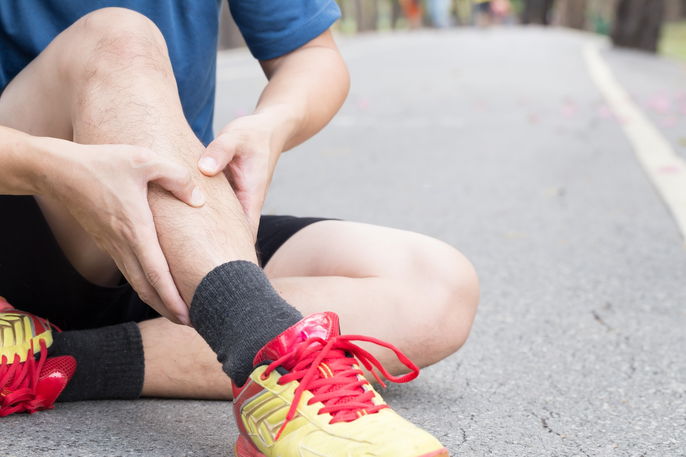Shin splints is characterized by an inflammation of the tibia and/or the muscles and tendons that are attached to this bone. This condition causes symptoms like intense pain in the front of the shin bone that is especially during or after physical activities.
This inflammation is more common in people who engage in repetitive impact sports, such as running, football, cycling or gymnastics, but it can also be the result of exercising on uneven surfaces, lack of stretching and even genetic conditions.
Treatment for shin splints, which is scientifically referred to as medial tibial stress syndrome, is typically guided by an orthopedic surgeon. Treatment involves rest, ice packs, physiotherapy or the use of anti-inflammatory medications.

What causes shin splints?
Shin splints are typically caused by:
- Frequent activity and sports, such as soccer, running or tennis
- High-impact physical activities, such as gymnastics
- Previous history of shin splints
- Use of inappropriate footwear
- Excessive leg workouts
- Carrying very heavy loads
- Flat feet
- High or very rigid foot arches
- Exercising on uneven ground
- Slips or trips
- Genetic factors
- Lack of stretching
Other factors that can contribute to shin splints include inadequate gait when running or walking, increasing workout frequency, changing your running pace or long-distance running.
Common symptoms
The main symptoms of shin splints are:
- Severe pain in front of the shin bone
- Swelling in the affected leg
- Shin pain during or after physical activity
- Shin pain that improves with rest
- Increased sensitivity to touch in the shin
These symptoms should be assessed by a doctor to confirm a diagnosis, so that appropriate treatment can be initiated.
Confirming a diagnosis
The diagnosis of shin splints is made by an orthopedic surgeon through an assessment of the patient's symptoms, health history, activity level and the physical shin.
You doctor may also order imaging tests, like an X-ray or MRI, to confirm a diagnosis and rule out other conditions that may present with similar symptoms, like a tibial stress fracture or chronic exertional compartment syndrome (CECS), for example.
Possible causes
Shin splints are caused by overload on the tibia bone, located in the shin, in the lower part of the leg, usually due to repetitive impact sports, leading to inflammation of the tibia, and/or the muscles and tendons that are attached to this bone.
Treatment options
Treatment for shin splints should be guided by a orthopedic surgeon. It is aimed at reducing inflammation in the tibia, tendons or muscles and relieving active symptoms.
The main treatments that may your doctor may recommend include:
1. Rest
Shin splints caused by frequent physical activity may be relieved with rest, as reducing activity can reduce pain, swelling and inflammation.
The doctor may advise swapping high-intensity sports to low-impact activities during recovery, like swimming.
You should not try to ignore the pain or continue training wit h it, as this can lead to even more inflammation and lead to a longer recovery time.
2. Cold compresses
Applying cold compresses to the shin may be advised by your doctor to help reduce pain and relieve inflammation.
To make an ice pack, place ice of a plastic bad or place a gel bag in the freezer to cool it, then wrap the compress in a clean dry towel and apply it to the shin. This can be done 3 to 4 times per day, for 15 to 20 minutes at a time, or as directed by your doctor.
3. Medications
Your doctor can prescribe analgesic and anti-inflammatory medications, such as acetaminophen, ibuprofen or naproxen, to help relieve pain and reduce tibial inflammation.
For shin splints that do not improve with rest, cold compresses, or changes in physical activity, the doctor may recommend calcium and vitamin D supplements to speed up recovery and prevent shin splints from progressing.
These medications should be taken as prescribed by a doctor, as dosing and treatment duration can vary depending on the intensity of pain and other presenting symptoms.
4. Physiotherapy
Physiotherapy can be prescribed by your doctor and guided by a physiotherapist. It may involve stretching and strengthening exercises for the leg muscles, as well as correction of leg movements and walking. It can help to speed-up recovery and relieve inflammation and pain in the shins.
Physiotherapy plans should be developed by a physiotherapist, as treatment approaches can vary on a case-by-case basis. The physiotherapist can also recommend suitable footwear for performing repetitive or high-impact sports, as well as warm-up or cooldown stretches to be done with activities. Gradual reintegration can guided by a physiotherapist so that the patient can return to their previous activity level.
When can I start running again?
Running can be restarted within weeks to months of starting treatment. This time varies according to the actions taken after the first symptom occurs. If you persist in exercising even when you feel pain, the recovery process may take longer and reintegration into sport may also be difficult.
To return to running as soon as possible and reduce the chances of experiencing pain again, it is important to stop exercising for at least two weeks, apply ice packs to the area and seek advice from a physiotherapist.
How to prevent
To prevent shin splints, it is very important to stretch and warm-up to prepare the muscles for activity. It is also important to consider the footwear you will be using, to ensure it is ideal for your gait and the surface the exercise will be performed on.
It is also recommended to perform exercises that strengthen the legs and to gradually increase intensity of exercises to prevent further injuries. Read more about a leg workout and different exercises that you can perform as approved by your doctor or physiotherapist.
Furthermore, you should never ignore any pain. If you feel shin splint pain, you should stop exercising and rest as soon as the first symptoms appear. This rest should continue until the swelling and pain improve.






























